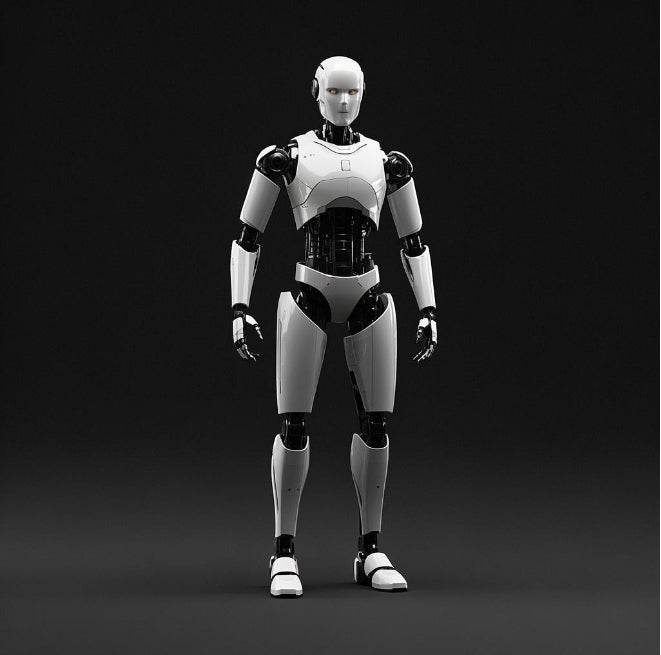
Three Application Fields of Humanoid Robots
In the current era where the tide of technology surges forward, humanoid robots have stepped out of science - fiction concepts and into reality. With their highly anthropomorphic forms and intelligent interaction capabilities, they are quietly infiltrating various fields. From bringing convenience to human life to driving industrial transformation, the application potential of humanoid robots is like a rich mine waiting to be excavated, exuding a fascinating charm.This article will elaborate on the applications of humanoid robots from three perspectives: industry, service, and education.
Ⅰ.Industry
With the continuous development of industry, changes in the working environment and the demand for improved work efficiency have led to a surge in the need for humanoid robots.Humanoid robots can replace humans in some dangerous and complex environments, such as those with nuclear radiation.Also, through the collaborative efforts directly among humanoid robots, work efficiency can be enhanced.
The UBTECH Walker S humanoid robot at a car factory

In industrial scenarios, there are many working environments that are dangerous, harsh, or difficult to reach for humans. Humanoid robots can show their unique advantages. For example, in the nuclear industry, after a nuclear power plant accident, the site has a high radiation risk, posing great challenges to maintenance and cleaning work. Humanoid robots can imitate human limb movements, flexibly move through the complex interior of nuclear facilities, and perform tasks such as inspecting and repairing equipment, preventing humans from being directly exposed to the radiation environment and ensuring personnel safety.
Currently, humanoid robots have increasingly extensive applications in manufacturing.These applications cover multiple aspects like goods handling, picking and placing, quality inspection, labeling, assembly, intelligent patrol inspection, and high - risk operations.For instance, in goods handling, the prototype of the humanoid robot "Optimus", unveiled by Tesla CEO Elon Musk at AI Day in 2022, showed its capacity to move boxes in a car factory.
Humanoid robots possess mobility and versatility, making them suitable for factory applications.Humanoid robots are part of embodied intelligence and can be extended to other applications in the future.Since the scenarios are fixed, and the tasks within those scenarios are determined. For these specific scenarios, we can develop customized hardware and software, conduct trials in certain fields first. Then, the data and technologies obtained from these trials can be fed back to general - purpose humanoid robots, ultimately making them humanity's closest assistants.
Ⅱ.Service
The application of humanoid robots in the service sector can significantly enhance service quality, enabling consumers to indulge in more advanced and premium services. These robots have the remarkable ability to operate continuously around the clock, unfettered by the limitations of human fatigue. Moreover, they are equipped with a plethora of intelligent functions. These capabilities range from sophisticated facial recognition for personalized greetings to in - depth language processing for seamless communication, allowing them to understand and meet customer needs with precision and efficiency.
The Fourier Intelligence humanoid robot of enters Bank.

The humanoid robot of Fourier Intelligence has entered the Shanghai Branch of China Construction Bank. They jointly set up a training base for commercial bank scenario applications. The robot can conduct simple conversations and help with tasks like number - taking in the lobby.
Additionally,the KIME robot produced by Macco Robotics shines across diverse sectors. In food and beverage service, be it restaurants or bars, it's a multitasker. It swiftly makes and serves a variety of items like beer, coffee, snacks, etc. With a high - speed output of two beer glasses every six seconds and 253 items per hour per kiosk, it runs 24/7 to meet customer demands.As a mobile bartender, it precisely controls elements like pressure and temperature to create perfect cocktails. For customer interaction, its 10.1 - inch touch - screen, along with multi - language voice and facial recognition, enables it to take orders and interact well. It pinpoints and caters to personalized needs, boosting service quality and customer satisfaction.
Ⅲ.Education
Humanoid robots are increasingly vital in education, innovating modern teaching.Their interactivity vividly sparks students' learning interest. In language classes, they simulate real - life intonations, chat with students, and correct pronunciations. In science experiments, they precisely demonstrate complex steps for better principle understanding.These robots offer personalized teaching. Analyzing learning data, they customize content and pace according to students' knowledge levels and learning styles. They patiently repeat for slower learners and provide extensions for advanced ones.Moreover, they create a new educational practice platform. In programming education, students program to control their movements, turning abstract knowledge into practical results and fostering logical and innovative thinking. This edutainment approach helps students enhance overall abilities and prepare for future development.
The SA01 bipedal robot enters the classroom.

The SA01 bipedal robot made its debut at a school in Guangzhou for the first time, presented as a scientific research teaching aid. This innovative move saw its introduction into the school's wheeled robot course, thereby providing students with a brand - new learning tool and practical platform. Thanks to the high scalability and advanced technology of the SA01, students are no longer restricted to the basic operations of traditional robots. Instead, they can delve into more complex applications of humanoid robots. This not only piques their interest in artificial intelligence and robot technology but also furnishes a novel approach to integrating theoretical knowledge with practical skills.
Ⅳ.Mass Production Plan
According to different research and development fields, the official data provided by each company for each robot has different focuses. For instance, for robots designed for the industrial field, parameters such as maximum load capacity, moving speed, and maximum peak torque are given. These parameters are crucial as they determine the robot's performance in industrial tasks like material handling and manufacturing operations. Robots for the service field, on the other hand, have specific data about their height, weight, as well as the number of body joints and degrees of freedom provided. This information is essential as it relates to the robot's appearance and its ability to interact with the service environment in a human - like manner. As for robots designed for the educational field, the emphasis is placed on introducing functions such as voice interaction. This is because voice interaction plays a vital role in engaging students, providing educational guidance, and facilitating learning processes.
Here are some basic parameters of the robot:

Although the mass production of humanoid robots has not reached a certain scale at present, robot companies have successively announced their mass - production plans.Here are some companies' mass - production plans for humanoid robots:
Tesla
At the 2024 Tesla Annual Shareholders' Meeting, Elon Musk revealed the plan to produce Optimus in small batches in 2025. The first - batch robots will be given priority for internal testing.. The goal is to achieve large - scale production in 2026, increasing the output by 10 times, reaching 50,000 to 100,000 units. These robots will be made available to other companies. Each robot is expected to cost $10,000 and be sold at around $20,000.
Agility Robotics
It plans to open a robot factory in Oregon in early 2024 to produce the bipedal robot Digit.. The initial production volume will be in the hundreds, with the ultimate goal of producing 10,000 units per year.
Boston Dynamics
Although its humanoid robot Atlas has made continuous technological progress, no clear mass - production plan has been announced yet. However, there are rumors that Boston Dynamics is actively exploring the application potential of Atlas in industrial, military, and scientific research fields. It may formulate a mass - production plan based on market demand and technological maturity in the future.
Fourier Intelligence
According to the South China Morning Post, it planned to start mass - producing its humanoid robot GR - 1 at the end of 2023 and deliver thousands of units in 2024.. This robot can walk at a speed of 5 kilometers per hour and carry a load of 50 kilograms.
Sanctuary AI
Its humanoid robot Phoenix is currently in the research, development, and testing stage. No specific mass - production schedule has been announced yet. But the company said it is actively promoting technological research and development and business cooperation to achieve the commercial mass - production of the robot.
Figure
The company is developing the humanoid robot Figure. Some prototype functions and test videos have been shown, but no mass - production plan or specific schedule has been disclosed.
Apptronik
Its humanoid robot Apollo is undergoing technical optimization and testing. The company plans to gradually increase production in the next few years, but no specific mass - production target and schedule have been announced.
2025 is the first year of mass production of humanoid robots. Look forward to the debut of humanoid robots!








